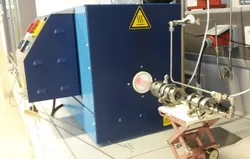Supported Metal and Metal Carbide Catalysts for Hydrogen Activation
Tungsten carbide is a promising material for the development of new catalysts for many different applications. This in other fields widely used and relatively cheap material possesses catalytic properties similar to those of Platinum, which lead to its use in electrocatalysis and most recently the upgrading of biomass.
The reduction of a tungsten precursor is followed by carburization and proceeds over the metastable tungsten semicarbide (W2C) to the thermodynamically favored tungsten monocarbide (WC). Tungsten oxides can also be processed to tungsten carbides. Even though the material is investigated for several decades, the preparation of a phase pure tungsten carbide remains challenging.

At the center of this research interest stands the investigation of tungsten carbide based catalysts as an alternative to precious metal catalysts in hydrogenation reactions. In the context of biomass upgrading, Ni modified tungsten carbide catalysts are studied for the catalytic hydrogenation of the platform chemicals furfural/furfuryl alcohol. Parameters influencing the selectivity of the catalysts such as the nickel particle size are studied in order to optimize the selectivity for ring opening.
Another objective is to improve the tungsten carbide synthesis conditions in order to lower the temperature needed for carburization.
Also, experiments are performed with the aim of better understanding general structure-activity relationships of tungsten carbide catalysts such as phase dependent catalytic activity (W2C vs. WC).

Analytical tools:
-
Infrared spectroscopy (IR) of gaseous components
-
Temperature programmed techniques (TPR, TPD)
-
X-ray powder diffraction (XRD)
Contact:
Patrick Schlachta (patrick.schlachta(at)tum.de)